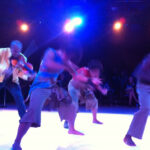“That age” – many remember that time when Hustle Dancing exploded into the mainstream. For many, like myself, it wasn’t even called “Hustle” initially, but it was the dance of the moment, a cultural phenomenon that sparked a lifelong passion for partner dancing. Learning from the iconic scenes of Saturday Night Fever and the televised excitement of Dance Fever, the nuances of counts and styles were completely lost on a self-taught beginner. Looking back, it was likely the 3-count rhythm that resonated most instinctively. Even now, the distinctions between 3-count and 6-count hustle remain somewhat unclear without deeper study. Today, witnessing hustle classes in studios, both 4-count and 3-count variations are taught. Beginner classes often focus solely on 4-count, while mixed or intermediate levels introduce 3-count or transition from 4 to 3, often counted to six, adding to the initial confusion for newcomers.
However, stepping outside the studio and into the current club scene reveals a different story. Many venues promoting dance nights seem to be dominated by Salsa.
Observing generational trends, there’s a noticeable gap in interest in partner dancing among younger demographics. Anecdotally, a millennial housemate shows little inclination towards any form of partner dance. While this is a small sample, it aligns with broader observations. Sharing space with a weekly Salsa event, it’s apparent that the Salsa crowd, while vibrant, seems to be comprised of individuals slightly older than the late millennial generation. This suggests Salsa’s peak popularity may be receding, and no other partner dance form has yet captured the attention of younger millennials in the same way.
The count itself is likely not the barrier to hustle dancing’s wider appeal among younger generations. The missing element is a strong pop culture catalyst. To reignite interest in hustle, perhaps a contemporary reimagining of Saturday Night Fever is needed. Imagine Channing Tatum or Derek Hough leading a revival, with soundtracks featuring artists like Selena Gomez, Elle Goulding, and Sam Harris. A pop culture moment could be the key to bringing hustle dancing back into the spotlight and onto the dance floors of a new generation.

